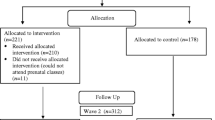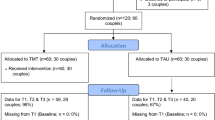This research was supported by a National Health and Medical Research Council of Australia grant entitled "Promoting a positive transition to parenthood" awarded to W. Kim Halford and Debra K. Creedy.
Abstract
The transition to parenthood is often associated with a decline in couple relationship adjustment. Couples (n = 71) expecting their first child were randomly assigned to either: (a) Becoming a Parent (BAP), a maternal parenting education program; or (b) Couple CARE for Parents (CCP), a couple relationship and parenting education program. Couples were assessed pre-intervention (last trimester of pregnancy), post-intervention (5 months postpartum), and follow-up (12 months postpartum). Relative to BAP, CCP reduced negative couple communication from pre- to post-intervention, and prevented erosion of relationship adjustment and self-regulation in women but not men from pre-intervention to follow-up. Mean parenting stress reflected positive adjustment to parenthood with no differences between BAP and CCP. CCP shows promise as a brief program that can enhance couple communication and women’s adjustment to parenthood.


Similar content being viewed by others
Notes
Usually a minimum of 4 to 5 assessment occasions are suggested for estimating curvilinear models (Singer and Willett 2003). We initially conducted a linear analysis, which showed significant intervention effects on each communication variable. However, given the plot of raw data suggests non-linear change, focusing on these linear analyses was deemed potentially misleading. The quadratic terms were able to estimated with the three times of assessment by modelling the time effect as fixed (i.e., the variance and covariance of slope were set to zero). Adding a quadratic term significantly improved the fit of the models (i.e., significantly reduced the deviance) for each of the three communication measures.
The ICC is a ratio of the deviance accounted for at level 2 (couple) divided by the sum of the deviance at levels 1 (time) and 2 (couple). Note we calculated the variance component analysis before entering the gender-specific terms into the model.
References
Abidin, R. (1990). Parenting Stress Index/Short Form. Charlottesville: Pediatric Psychology.
Armstrong, K. L., O’Donnell, H., McCallum, R., & Dadds, M. R. (1998). Childhood sleep problems: Association with prenatal factors and maternal distress/depression. Journal of Paediatrics and Child Health, 34, 263–266.
Atkins, D. C. (2005). Using multilevel models to analyze couple and family treatment data: Basic and advanced issues. Journal of Family Psychology, 19, 98–110.
Australian Bureau of Statistics. (2003). Education and work (category number 6227.0). Retrieved February 25, 2005 from http://www.abs.gov.au/Ausstats/abs.
Bornstein, P. H., & Rychtarik, R. G. (1983). Consumer satisfaction in adult behavior therapy. Behavior Therapy, 14, 191–208.
Bradbury, T. N., & Karney, B. R. (2004). Understanding and altering the longitudinal course of intimate partnerships. Journal of Marriage and the Family, 61, 451–463.
Braukhaus, C., Hahlweg, K., Kroeger, C., Groth, T., & Fehm-Wolfsdorf, G. (2003). The effects of adding booster sessions to a prevention training program for committed couples. Behavioural and Cognitive Psychotherapy, 3, 325–336.
Carey, M., Spector, I., Lantiga, L., & Krauss, D. (1993). Reliability of the Dyadic Adjustment Scale. Psychological Assessment, 5, 238–240.
Cowan, C., & Cowan, P. (2000). When partners become parents: The big life change for couples. Mahweh, NJ: Erlbaum.
Cox, M. J., Paley, B., Burchinal, M., & Payne, C. C. (1999). Marital perceptions and interactions across the transition to parenthood. Journal of Marriage and the Family, 61, 611–625.
Doherty, W. J., Erickson, M. F., & LaRossa, R. (2006). An intervention to increase father involvement and skills with infants during the transition to parenthood. Journal of Family Psychology, 20, 438–447.
Emmanuel, E., Creedy, D., & Fraser, J. (2001). What mothers want: A postnatal survey. Australian Journal of Midwifery, 14, 16–20.
Fabian, M., Radestad, I. J., & Waldenström, U. (2004). Characteristics of Swedish women who do not attend childbirth and parenthood education classes during pregnancy. Midwifery, 20, 226–235.
Feeney, J. A., Hohaus, L., Noller, P., & Alexander, R. P. (2001). Becoming parents: Exploring the bonds between mothers, fathers, and their infants. New York: Cambridge University Press.
Gagnon, A. J. (2001). Individual or group antenatal education for childbirth/ parenthood (Cochrane Review). In Cochrane Library, Issue 2: Oxford: Update software.
Halford, W. K., Sanders, M. R., & Behrens, B. C. (2001). Can skills training prevent relationship problems in at-risk couples? Four-year effects of a behavioral relationship education program. Journal of Family Psychology, 15, 750–768.
Halford, W. K., Moore, E. M., Wilson, K. L., Dyer, C., & Farrugia, C. (2004). Benefits of a flexible delivery relationship education: An evaluation of the Couple CARE program. Family Relations, 53, 469–476.
Halford, W. K., O’Donnell, C., Lizzio, A., & Wilson, K. L. (2006). Brief report: Do couples at high-risk of relationship problems attend pre-marriage education? Journal of Family Psychology, 20, 160–163.
Halford, W. K., Lizzio, A., Wilson, K. L., & Occhipinti, S. (2007). Does working at your relationship help? Couple relationship self-regulation and satisfaction in the first 4 years of marriage. Journal of Family Psychology, 21, 185–194.
Halford, W. K., Markman, H. J., & Stanley, S. (2008). Strengthening couple relationships with education: Social policy and public health perspectives. Journal of Family Psychology, 22, 497–505.
Hawkins, A. J., Fawcett, E. B., Carroll, J. S., & Gilliland, T. T. (2006). The Marriage Moments program for couples transitioning to parenthood: Divergent conclusions from formative and summative evaluation data. Journal of Family Psychology, 20, 561–570.
Hawkins, A. J., Blanchard, V. L., Baldwin, S. A., & Fawcett, E. B. (2008). Does marriage and relationship education work? A meta-analytic study. Journal of Consulting and Clinical Psychology, 76, 723–734.
Jacobson, N. S., & Truax, P. (1991). Clinical significance: A statistical approach to defining meaningful change in psychotherapy research. Journal of Consulting and Clinical Psychology, 59, 12–19.
Lawrence, E., Rothman, A. D., Cobb, R. J., Rothman, M. T., & Bradbury, T. N. (2008). Marital satisfaction across the transition to parenthood. Journal of Family Psychology, 22, 41–50.
Midmer, D., Wilson, L., & Cummings, S. (1995). A randomized controlled trial of the influence of prenatal parenting education on postpartum anxiety and martial adjustment. Family Medicine, 27, 200–205.
Nolan, M. L. (1997). Antenatal education: What next? Journal of Advanced Nursing, 25, 1198–1204.
Nomaguchi, K. M., & Milkie, M. A. (2003). Costs and rewards of children: The effects of becoming a parent on adults’ lives. Journal of Marriage and Family, 65, 356–374.
Petch, J., & Halford, W. K. (2008). Psycho-education to enhance couples’ transition to parenthood. Clinical Psychology Review, 28, 1125–1137.
Rasbash, J., Browne, W., Healey, M., Cameron, B., & Charlton, C. (2005). MLwin version 2.2. Bristol, UK: University of Bristol Centre for Multi-level Modelling.
Rogge, R. D., Cobb, R. J., Story, L. B., Johnson, M. D., Lawrence, E. E., Rothman, A. D., et al. (2006). Recruitment and selection of couples for intervention research: Achieving developmental homogeneity at the cost of demographic diversity. Journal of Consulting and Clinical Psychology, 74, 774–784.
Sanders, M. R., Halford, W. K., & Behrens, B. C. (1999). Parental divorce and communication in engaged couples. Journal of Family Psychology, 14, 60–78.
Schulz, M. S., Cowan, P. A., & Cowan, C. P. (2006). Promoting Healthy Beginnings: A randomized controlled trial of a preventive intervention to preserve marital quality during the transition to parenthood. Journal of Clinical and Consulting Psychology, 74, 20–31.
Shapiro, A. F., & Gottman, J. M. (2005). Effects on marriage of a psycho-education intervention with couples undergoing the transition to parenthood, evaluation at 1-year post-intervention. Journal of Family Communication, 5, 1–24.
Shapiro, A. F., Gottman, J. M., & Carrere, S. (2000). The baby and the marriage: Identifying factors that buffer against decline in marital satisfaction after the first baby arrives. Journal of Family Psychology, 14, 59–70.
Singer, J. D., & Willett, J. B. (2003). Applied longitudinal data analysis: Modeling change and event occurrence. New York: Oxford University Press.
Spanier, G. B. (1976). Measuring dyadic adjustment: New scales for assessing the quality of marriage and similar dyads. Journal of Marriage and the Family, 38, 15–28.
Wilson, K. L., Charker, J., Lizzio, A., Halford, W. K., & Kimlin, S. (2005). Assessing how much couples work at their relationship: The Behavioral Self-regulation for Effective Relationships Scale. Journal of Family Psychology, 19, 385–393.
Author information
Authors and Affiliations
Corresponding author
Rights and permissions
About this article
Cite this article
Halford, W.K., Petch, J. & Creedy, D.K. Promoting a Positive Transition to Parenthood: A Randomized Clinical Trial of Couple Relationship Education. Prev Sci 11, 89–100 (2010). https://doi.org/10.1007/s11121-009-0152-y
Published:
Issue Date:
DOI: https://doi.org/10.1007/s11121-009-0152-y




